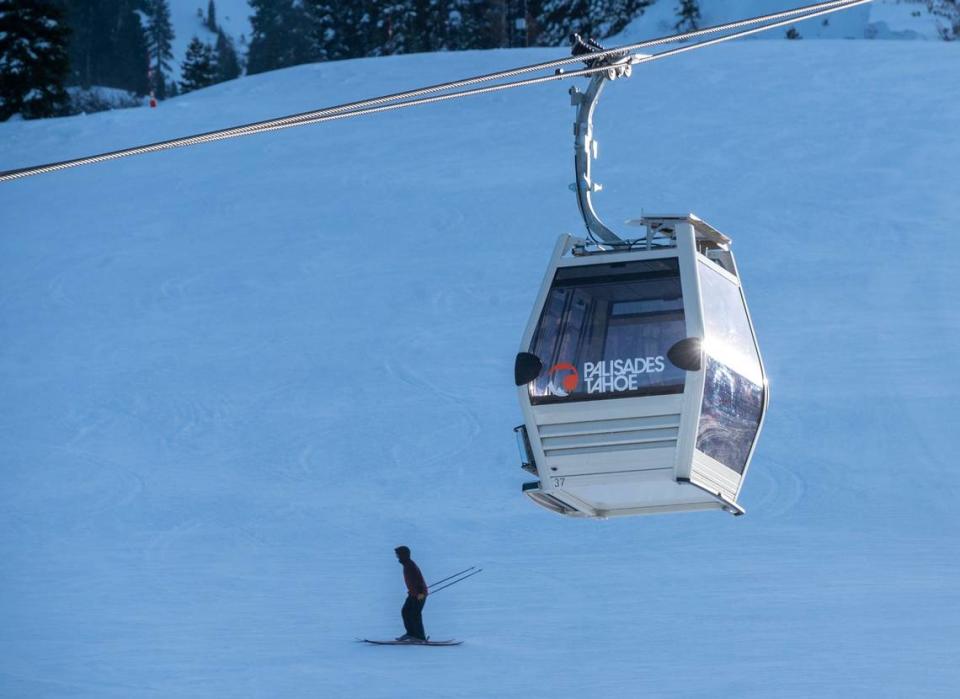What caused reported avalanches at Palisades Tahoe, that killed 1? Experts offer theories
A fresh blanket of snow conceals the historical capsule of weather events that buffet the Sierra Nevada’s slopes.
This time capsule is found in the snowpack’s distinct layers. It is where, some experts say, there may be clues as to why two reported avalanches, one of which killed a 66-year-old man, cascaded through Palisades Tahoe in the Olympic Valley this past week.
“You can think of it as similar to the rings of a tree if you took a cross section,” said Ethan Greene, director of the Colorado Avalanche Information Center.
Another avalanche expert said the cause isn’t so simple. Each expert, however, agreed that avalanche science only goes so far and often there’s no predicting when icy sheets may loosen.
“But at the end of the day, it’s Mother Nature and sometimes she throws a bit of a wild card at you,” said Larry Heywood, a snow safety consultant.
Snow and rock barreled Wednesday into Palisades Tahoe from expert ski lift KT-22 standing at 8,000 feet. Debris — that Placer County sheriff’s deputies said spread 150 feet wide, 450 feet long and 10 feet deep — buried multiple people and killed Kenneth Kidd, a Point Reyes and Truckee resident. Three others suffered non-life threatening wounds, Palisades Tahoe ski resort staff said.
The following day, another snowslide cascaded through Wolverine Bowl on the Alpine Meadows side of Palisades Tahoe. No one was injured, Patrick Lacey, a spokesman with Palisades Tahoe, has said.
What’s in a snowpack?
Architects of a snowpack include weather, climate and terrain. Each affects a snowpack’s stability and how it forms atop a slope, said Simon Trautman, the director of the Avalanche Center, run by the U.S. Forest Service. Trautman wasn’t commenting directly about Palisades Tahoe’s avalanches and spoke generally about them.
Further complicating this phenomenon, water can exist as a liquid, solid and gas at one temperature and snow can change within that structure, he said. Terrain is dynamic too, though it isn’t altered as quickly as weather, he added.
Avalanche danger may fluctuate on an hourly basis, he added.
The uncertainty prompts avalanche forecasters at ski resorts to monitor the interconnection between weather, temperature, wind speed, wind direction and a variety of other factors very closely throughout a day, Heywood said. His knowledge of avalanche risk comes from the 34 years he spent as a snow safety director at Alpine Meadows Ski Resort; he has no direct knowledge of the recent avalanches.
Ski patrols — tasked with safety of guests at resorts — begin watching the powder as soon as winter begins as well, Heywood said. Spindrifts blowing snowflakes from one portion of the mountain to another spot can weaken or strengthen slopes, he said.
Large powder dumps in a shorter period of time can create more instability and increase chances for avalanches, Heywood added.
Snowslides’ danger spikes when large weather events — such as precipitation and strong winds — unleash upon mountains and alter each layer, he added. Frozen sheets break at striations in a snowpack so experts monitor how each sheet will impact another, Greene said.
‘Something heavy on something light’
The Western United States experienced dry spells for years before rounds of moisture erased extreme drought conditions in California with at least 17 people dying last year in the golden state as torrential rain pounded regions.
That sudden change may explain the instability in Palisades Tahoe’s snowpack. A heavy moisture-rich snow on top of powdery snowfall can be a dangerous combination, experts said.
“It’s like putting something heavy on something light,” Heywood said of the striations created in the snowpack.
Brian Brong, a meteorologist with the National Weather Service station in Reno, said year round snow levels on the Sierra Nevada depends on how much powder dropped over its peaks and how hot summer temperatures reach.
Last year, there were pockets of snow in Olympic Valley until September because of a heavy moisture year, Brong said. Powder typically falls from October until about June, he added. Last year, there were pockets of snow in Olympic Valley until September because of a heavy moisture year, Brong said. Powder typically falls from October until about June, he added.

Greene, the director of the Colorado Avalanche Information Center, said previously years’ weather systems that shaped snowpacks often don’t matter. That’s because ice completely melts year after year in certain places, leading powder layers to be examined on a yearly basis, he said, while noting he wasn’t directly commenting on Palisades Tahoe.
Avalanches are unpredictable and it’s not clear what data avalanche forecasters examined in the days leading up to the Palisades’ avalanches.
The Placer County Sheriff’s Office has said the avalanche is under investigation.
Michael Gross, the vice president of mountain operations for Palisades Tahoe, said during a Wednesday news conference that ski resort staff conducted “avalanche control assessments” in the days leading up to opening KT-22, the area where the snowslide swept through. Experts with the mountain resort looked at forecasts, snowpack, wind direction and other conditions to determine whether areas were safe, he said.
“Based on our expertise and our experience and history, we deemed this condition safe,” Gross said.
Palisades Tahoe’s two reported avalanches are also unusual because they happened within an open area of the ski resort, known as inbounds, Green said. Most avalanches happened in the backcountry. The National Avalanche Center, which ranks backcountry areas and not ski, said there was a considerable risk of danger for an avalanche in the Olympic Valley on Wednesday and Thursday.
Only about 3% percent of avalanche deaths happen in open ski areas, Greene said.
Learn more
You can find the most up-to-date avalanche forecasts for Lake Tahoe area backcountry at www.sierraavalanchecenter.org/forecasts.

